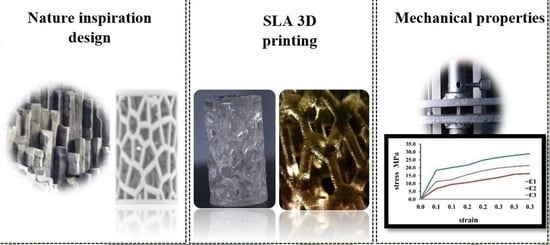Effect of Cell Geometry on the Mechanical Properties of 3D Voronoi Tessellation
Abstract
1. Introduction
2. Materials and Methods
2.1. Three-Dimensional (3D) Voronoi Structure
- I.
- Homogeneous cylinder E1 and N1: the number of seeds was evenly distributed throughout the cylinder with the dimensions R = 3.27 mm and H = 12 mm, as shown in Figure 3. The number of distributed seeds was 110 and 200 for E1 and N1, respectively.
- II.
- Gradient I cylinder E2 and N2: the cylinder was divided into two regions; the middle was hollow, so the core of the cylinder did not have any cells. The remainder was the perimeter, which had several seeds distributed throughout it, numbering 125 and 250 for E2 and N2, respectively, with the dimensions R = 3.27 mm, r = 1 mm, and H = 12 mm.
- III.
- Gradient II cylinder E3 and N3: the same as the previous design, but with a difference in that the core was filled with seeds. The core had approximately 20 seeds while the perimeter had 100 and 215 seeds for E3 and N3, respectively. Hence, the core was less dense compared to the perimeter.
2.2. Printing
2.3. Mechanical Testing
2.3.1. Compressive Testing
2.3.2. Stress–Strain Curve
2.3.3. Total Energy Absorption (TEA)
2.3.4. Specific Energy Absorption (SEA)
3. Results and Discussion
3.1. Results
3.1.1. Density and Porosity of Samples
3.1.2. Mechanical Properties
3.1.3. Energy–Displacement Curve
3.2. Discussion
3.2.1. Mechanical Properties and Energy Absorption
3.2.2. Failure Mode
4. Conclusions
- IEVSs were proven to bear higher stress than INVSs, as well as outperforming them in terms of energy absorption.
- IEVSs showed better performance in terms of resistance to fracture, with a higher displacement rate than INVSs, which explains their high energy absorption.
- In terms of the three designed models, the gradient I Voronoi structure model (E2 and N2) presented a higher apparent Young’s modulus than the gradient II Voronoi structures and the homogeneous structure due to the improved design features. Meanwhile, the homogeneous structures exhibited greater stiffness than the rest.
- In general, the mechanical properties are greatly affected by the geometric design of the Voronoi structures. For the gradient I and II cylinders, elongated Voronoi structures possess superior mechanical properties compared to normal Voronoi structures.
Author Contributions
Funding
Institutional Review Board Statement
Informed Consent Statement
Data Availability Statement
Acknowledgments
Conflicts of Interest
Appendix A

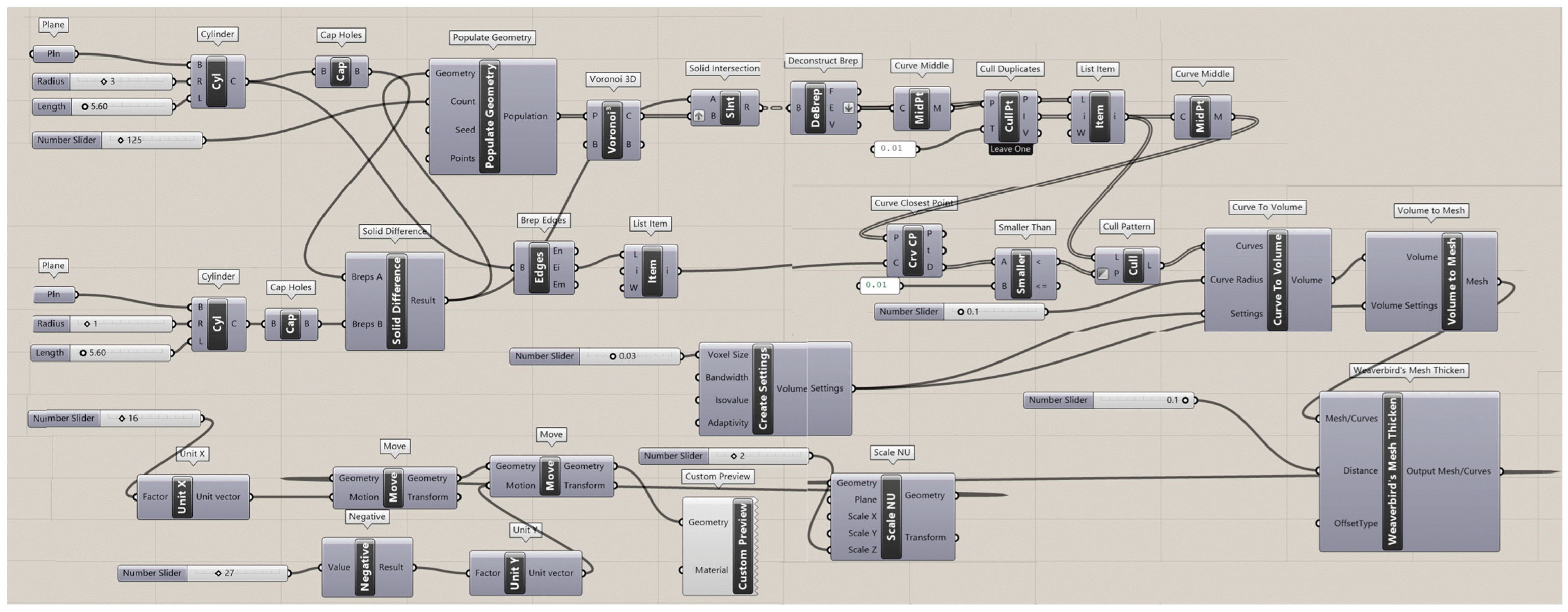


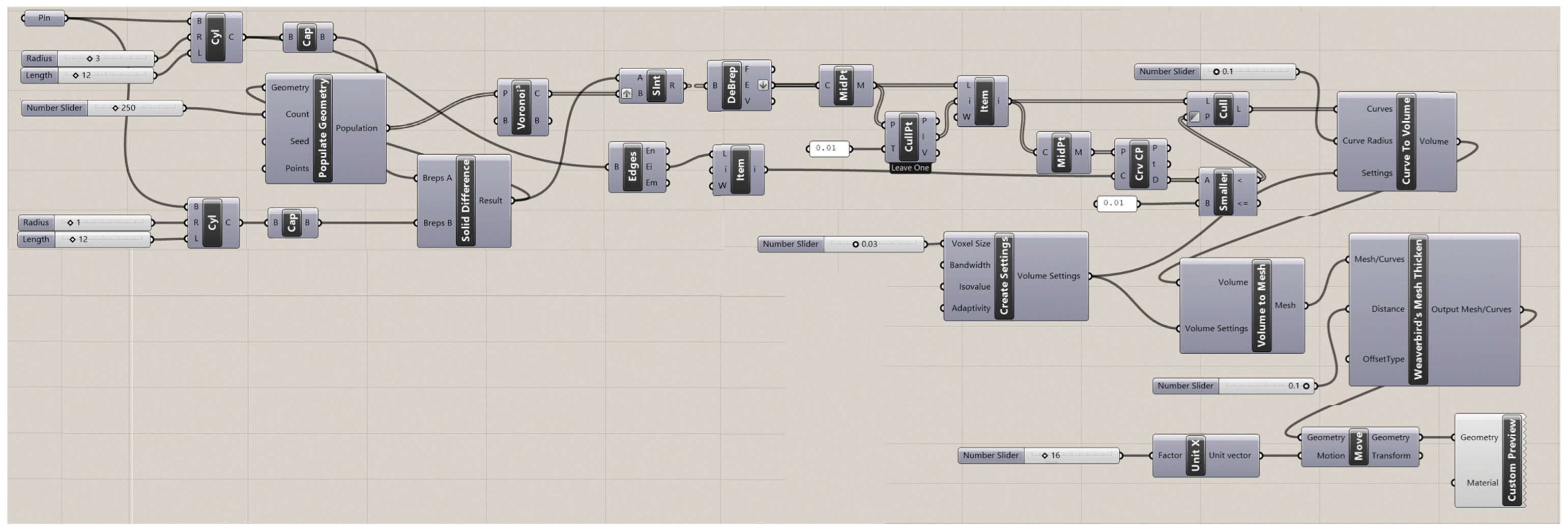

References
- Cima, L.G.; Vacanti, J.P.; Vacanti, C.; Ingber, D.; Mooney, D.; Langer, R. Tissue engineering by cell transplantation using degradable polymer substrates. J. Biomech. Eng. 1991, 113, 143–151. [Google Scholar] [CrossRef]
- Enderle, J. Introduction to Biomedical Engineering; Academic Press: Cambridge, MA, USA, 2012; ISBN 0123749794. [Google Scholar]
- Langer, R.; Vacanti, J.P. Tissue engineering. Science 1993, 260, 920–926. [Google Scholar] [CrossRef]
- Karageorgiou, V.; Kaplan, D. Porosity of 3D Biomaterial Scaffolds and Osteogenesis. Biomaterials 2005, 26, 5474–5491. [Google Scholar] [CrossRef]
- Zhang, J.; Barbieri, D.; Ten Hoopen, H.; De Bruijn, J.D.; Van Blitterswijk, C.A.; Yuan, H. Microporous calcium phosphate ceramics driving osteogenesis through surface architecture. J. Biomed. Mater. Res. Part A 2015, 103, 1188–1199. [Google Scholar] [CrossRef]
- Thomas, D.; Singh, D. Novel techniques of engineering 3D vasculature tissue for surgical procedures. Am. J. Surg. 2019, 218, 235–236. [Google Scholar] [CrossRef]
- Ahmadi, S.M.; Yavari, S.A.; Wauthle, R.; Pouran, B.; Schrooten, J.; Weinans, H.; Zadpoor, A.A. Additively manufactured open-cell porous biomaterials made from six different space-filling unit cells: The mechanical and morphological properties. Materials 2015, 8, 1871–1896. [Google Scholar] [CrossRef]
- Kantaros, A.; Chatzidai, N.; Karalekas, D. 3D printing-assisted design of scaffold structures. Int. J. Adv. Manuf. Technol. 2016, 82, 559–571. [Google Scholar] [CrossRef]
- Shirzad, M.; Zolfagharian, A.; Matbouei, A.; Bodaghi, M. Design, evaluation, and optimization of 3D printed truss scaffolds for bone tissue engineering. J. Mech. Behav. Biomed. Mater. 2021, 120, 104594. [Google Scholar] [CrossRef]
- Zhu, L.; Liang, H.; Lv, F.; Xie, D.; Wang, C.; Mao, Y.; Yang, Y.; Tian, Z.; Shen, L. Design and Compressive Fatigue Properties of Irregular Porous Scaffolds for Orthopedics Fabricated Using Selective Laser Melting. ACS Biomater. Sci. Eng. 2021, 7, 1663–1672. [Google Scholar] [CrossRef]
- Du, Y.; Liang, H.; Xie, D.; Mao, N.; Zhao, J.; Tian, Z.; Wang, C.; Shen, L. Design and statistical analysis of irregular porous scaffolds for orthopedic reconstruction based on voronoi tessellation and fabricated via selective laser melting (SLM). Mater. Chem. Phys. 2020, 239, 121968. [Google Scholar] [CrossRef]
- Chen, H.; Liu, Y.; Wang, C.; Zhang, A.; Chen, B.; Han, Q.; Wang, J. Design and properties of biomimetic irregular scaffolds for bone tissue engineering. Comput. Biol. Med. 2021, 130, 104241. [Google Scholar] [CrossRef]
- Voronoi, G. Nouvelles applications des parametres continus a la theorie des forms quadratiques. J. Reine Angew. Math. 1908, 133, 97–178. [Google Scholar] [CrossRef]
- Schaedler, T.A.; Jacobsen, A.J.; Torrents, A.; Sorensen, A.E.; Lian, J.; Greer, J.R.; Valdevit, L.; Carter, W.B. Ultralight metallic microlattices. Science 2011, 334, 962–965. [Google Scholar] [CrossRef] [PubMed]
- Alkhader, M.; Vural, M. Mechanical response of cellular solids: Role of cellular topology and microstructural irregularity. Int. J. Eng. Sci. 2008, 46, 1035–1051. [Google Scholar] [CrossRef]
- Zhu, H.X.; Thorpe, S.M.; Windle, A.H. The effect of cell irregularity on the high strain compression of 2D Voronoi honeycombs. Int. J. Solids Struct. 2006, 43, 1061–1078. [Google Scholar] [CrossRef]
- Bouakba, M.; Bezazi, A.; Scarpa, F. FE analysis of the in-plane mechanical properties of a novel Voronoi-type lattice with positive and negative Poisson’s ratio configurations. Int. J. Solids Struct. 2012, 49, 2450–2459. [Google Scholar] [CrossRef]
- Tekoğlu, C.; Gibson, L.J.; Pardoen, T.; Onck, P.R. Size effects in foams: Experiments and modeling. Prog. Mater. Sci. 2011, 56, 109–138. [Google Scholar] [CrossRef]
- Zhu, H.X.; Thorpe, S.M.; Windle, A.H. The geometrical properties of irregular two-dimensional Voronoi tessellations. Philos. Mag. A Phys. Condens. Matter Struct. Defects Mech. Prop. 2001, 81, 2765–2783. [Google Scholar] [CrossRef]
- Li, J.; Tanaka, H. Feasibility study applying a parametric model as the design generator for 3D–printed orthosis for fracture immobilization. 3D Print. Med. 2018, 4, 1. [Google Scholar] [CrossRef]
- Kladovasilakis, N.; Tsongas, K.; Tzetzis, D. Finite element analysis of orthopedic hip implant with functionally graded bioinspired lattice structures. Biomimetics 2020, 5, 44. [Google Scholar] [CrossRef]
- Uí Mhurchadha, S.M.; Marques, S.; Givet, L.; Raghavendra, R. Effect of Voronoi Lattice Geometry on the Fatigue Performance of Ti-6Al-4V; University of Texas: Austin, TX, USA, 2021; pp. 13–22. [Google Scholar]
- Fantini, M.; Curto, M.; De Crescenzio, F. A method to design biomimetic scaffolds for bone tissue engineering based on Voronoi lattices. Virtual Phys. Prototyp. 2016, 11, 77–90. [Google Scholar] [CrossRef]
- Wu, H.; Chao, L.; Zhang, Q.; Yi, Y.; Jiao, C.; Ye, Y.; Shen, L.; Zhao, J.; Wu, G.; Wang, C. Design and 3D printing of ceramic maxillofacial prosthesis with gradient pores based on Voronoi-Tessellation principle. Mater. Today Commun. 2022, 33, 104559. [Google Scholar] [CrossRef]
- Sotomayor, O.E.; Tippur, H.V. Role of cell regularity and relative density on elasto-plastic compression response of random honeycombs generated using Voronoi diagrams. Int. J. Solids Struct. 2014, 51, 3776–3786. [Google Scholar] [CrossRef]
- Do, Q.T.; Nguyen, C.H.P.; Choi, Y. Homogenization-based optimum design of additively manufactured Voronoi cellular structures. Addit. Manuf. 2021, 45, 102057. [Google Scholar] [CrossRef]
- Zhao, H.; Han, Y.; Pan, C.; Yang, D.; Wang, H.; Wang, T.; Zeng, X.; Su, P. Design and mechanical properties verification of gradient voronoi scaffold for bone tissue engineering. Micromachines 2021, 12, 664. [Google Scholar] [CrossRef]
- Rhea, M. Diabse Rock in Nature, the Strongest Rock in the World. Rockhound Resour. 2022. Available online: https//rockhoundresource.com/the-strongest-rock-in-the-world/ (accessed on 27 June 2022).
- Jiang, Q.; Feng, X.T.; Hatzor, Y.H.; Hao, X.J.; Li, S. jun Mechanical anisotropy of columnar jointed basalts: An example from the Baihetan hydropower station, China. Eng. Geol. 2014, 175, 35–45. [Google Scholar] [CrossRef]
- Maspero, F.A.; Ruffieux, K.; Müller, B.; Wintermantel, E. Resorbable defect analog PLGA scaffolds using CO2 as solvent: Structural characterization. J. Biomed. Mater. Res. 2002, 62, 89–98. [Google Scholar] [CrossRef]
- Loh, Q.L.; Choong, C. Three-dimensional Scaffolds for Tissue Engineering Applications: Role of Porosity and Pore Size. Tissue Eng. Part B Rev. 2012, 19, 1–61. [Google Scholar] [CrossRef]
- Hollinger, J.O.; Hu, Y.; Grainger, D.W.; Winn, S.R. Fabrication of poly(α-hydroxy acid) foam scaffolds using multiple solvent systems. J. Biomed. Mater. Res. 2002, 59, 563–572. [Google Scholar] [CrossRef]
- Guarino, V.; Causa, F.; Taddei, P.; di Foggia, M.; Ciapetti, G.; Martini, D.; Fagnano, C.; Baldini, N.; Ambrosio, L. Polylactic acid fibre-reinforced polycaprolactone scaffolds for bone tissue engineering. Biomaterials 2008, 29, 3662–3670. [Google Scholar] [CrossRef]
- Anycubic, C. Anycubic Plant-Based UV Resin. 2022, p. 17062658. Available online: https://www.anycubic.com/products/anycubic-plant-based-uv-resin (accessed on 16 July 2022).
- Gere, J.M.; Goodno, B.J. Mechanics of Materials, 8th ed.; Gere, J.M., Goodno, B.J., Christopher, M.S., Eds.; Cengage Learning. Global Engineering: Boston, MA, USA, 2013; Volume 1999, ISBN 9781111577742. [Google Scholar]
- Al-Qrimli, F.A.M. The effect of composite tubes subjected to axial loading comparing with the number of layers and geometry. Aust. J. Basic Appl. Sci. 2011, 5, 607–616. [Google Scholar]
- AL-Qrimli, H.; Khalid, K.; Mahdi, F. The Effect of Cone Angle on Composite Tubes Subjected to Axial Loading. Br. J. Appl. Sci. Technol. 2015, 7, 351–363. [Google Scholar] [CrossRef]
- Hollister, S.J. Porous scaffold design for tissue engineering (vol 4, pg 518, 2005). Nat. Mater. 2006, 5, 590. [Google Scholar] [CrossRef]
- Mantila Roosa, S.M.; Kemppainen, J.M.; Moffitt, E.N.; Krebsbach, P.H.; Hollister, S.J. The pore size of polycaprolactone scaffolds has limited influence on bone regeneration in an in vivo model. J. Biomed. Mater. Res. Part A 2010, 92, 359–368. [Google Scholar] [CrossRef] [PubMed]
- Li, G.; Wang, L.; Pan, W.; Yang, F.; Jiang, W.; Wu, X.; Kong, X.; Dai, K.; Hao, Y. In vitro and in vivo study of additive manufactured porous Ti6Al4V scaffolds for repairing bone defects. Sci. Rep. 2016, 6, 34072. [Google Scholar] [CrossRef]
- Frayssinet, E.; Colabella, L.; Cisilino, A.P. Design and assessment of the biomimetic capabilities of a Voronoi-based cancellous microstructure. J. Mech. Behav. Biomed. Mater. 2022, 130, 105186. [Google Scholar] [CrossRef]
- Jang, D.W.; Franco, R.A.; Sarkar, S.K.; Lee, B.T. Fabrication of porous hydroxyapatite scaffolds as artificial bone preform and its biocompatibility evaluation. ASAIO J. 2014, 60, 216–223. [Google Scholar] [CrossRef]
- Xu, N.; Ye, X.; Wei, D.; Zhong, J.; Chen, Y.; Xu, G.; He, D. 3D artificial bones for bone repair prepared by computed tomography-guided fused deposition modeling for bone repair. ACS Appl. Mater. Interfaces 2014, 6, 14952–14963. [Google Scholar] [CrossRef]
- Öncel, A.C.; Yaman, U. Generation of optimized voronoi based interior structures for improved mechanical properties. Procedia Manuf. 2019, 38, 42–51. [Google Scholar] [CrossRef]
- Gao, H.; Yang, J.; Jin, X.; Qu, X.; Zhang, F.; Zhang, D.; Chen, H.; Wei, H.; Zhang, S.; Jia, W.; et al. Porous tantalum scaffolds: Fabrication, structure, properties, and orthopedic applications. Mater. Des. 2021, 210, 110095. [Google Scholar] [CrossRef]
- Sun, Y.; Finne-Wistrand, A.; Albertsson, A.C.; Xing, Z.; Mustafa, K.; Hendrikson, W.J.; Grijpma, D.W.; Moroni, L. Degradable amorphous scaffolds with enhanced mechanical properties and homogeneous cell distribution produced by a three-dimensional fiber deposition method. J. Biomed. Mater. Res. Part A 2012, 100 A, 2739–2749. [Google Scholar] [CrossRef]
- Wang, B.; Arab, A.; Xie, J.; Chen, P. The Influence of Microstructure on the Flexural Properties of 3D Printed Zirconia Part via Digital Light Processing Technology. Materials 2022, 15, 1602. [Google Scholar] [CrossRef] [PubMed]
- Yin, H.; Huang, X.; Scarpa, F.; Wen, G.; Chen, Y.; Zhang, C. In-plane crashworthiness of bio-inspired hierarchical honeycombs. Compos. Struct. 2018, 192, 516–527. [Google Scholar] [CrossRef]
- Du, Y.; Liang, H.; Xie, D.; Mao, N.; Zhao, J.; Tian, Z.; Wang, C.; Shen, L. Finite element analysis of mechanical behavior, permeability of irregular porous scaffolds and lattice-based porous scaffolds. IOP Sci. Ltd. Mater. Res. Express 2019, 6, 10457. [Google Scholar] [CrossRef]
- Sienkiewicz, J.; Płatek, P.; Jiang, F.; Sun, X.; Rusinek, A. Investigations on the mechanical response of gradient lattice structures manufactured via slm. Metals 2020, 10, 213. [Google Scholar] [CrossRef]
- Pawlak, A.; Szymczyk, P.; Ziolkowski, G.; Chlebus, E.; Dybala, B. Fabrication of microscaffolds from Ti-6Al-7Nb alloy by SLM. Rapid Prototyp. J. 2015, 21, 393–401. [Google Scholar] [CrossRef]
- Liu, F.; Ran, Q.; Zhao, M.; Zhang, T.; Zhang, D.Z.; Su, Z. Additively manufactured continuous cell-size gradient porous scaffolds: Pore characteristics, mechanical properties and biological responses in vitro. Materials 2020, 13, 2589. [Google Scholar] [CrossRef]
- Chao, L.; Jiao, C.; Liang, H.; Xie, D.; Shen, L.; Liu, Z. Analysis of Mechanical Properties and Permeability of Trabecular-Like Porous Scaffold by Additive Manufacturing. Front. Bioeng. Biotechnol. 2021, 9, 779854. [Google Scholar] [CrossRef]
- Nazir, A.; Arshad, A.B.; Jeng, J.Y. Buckling and post-buckling behavior of uniform and variable-density lattice columns fabricated using additive manufacturing. Materials 2019, 12, 3539. [Google Scholar] [CrossRef]
- Soro, N.; Brodie, E.G.; Abdal-hay, A.; Alali, A.Q.; Kent, D.; Dargusch, M.S. Additive manufacturing of biomimetic Titanium-Tantalum lattices for biomedical implant applications. Mater. Des. 2022, 218, 110688. [Google Scholar] [CrossRef]
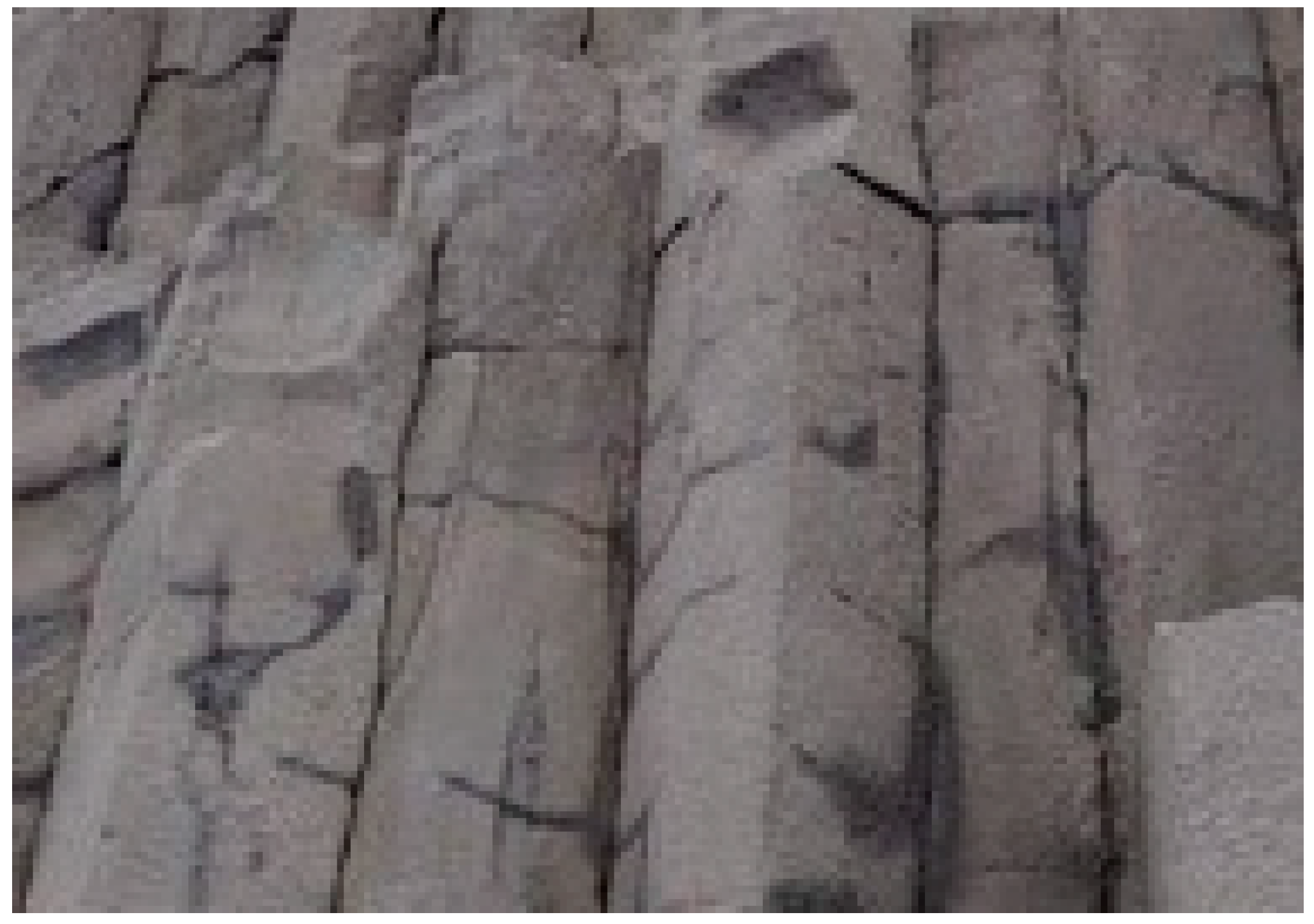
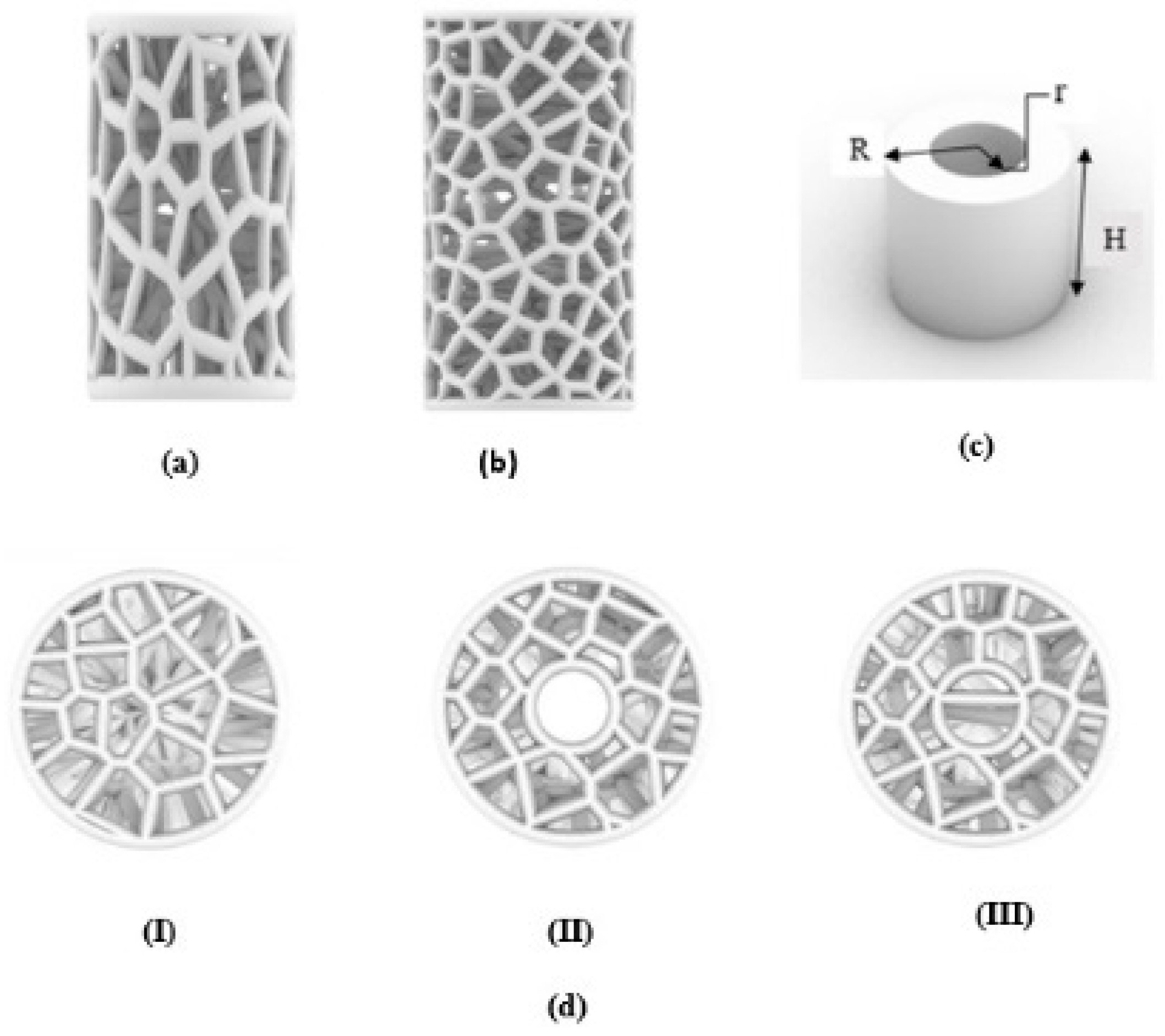

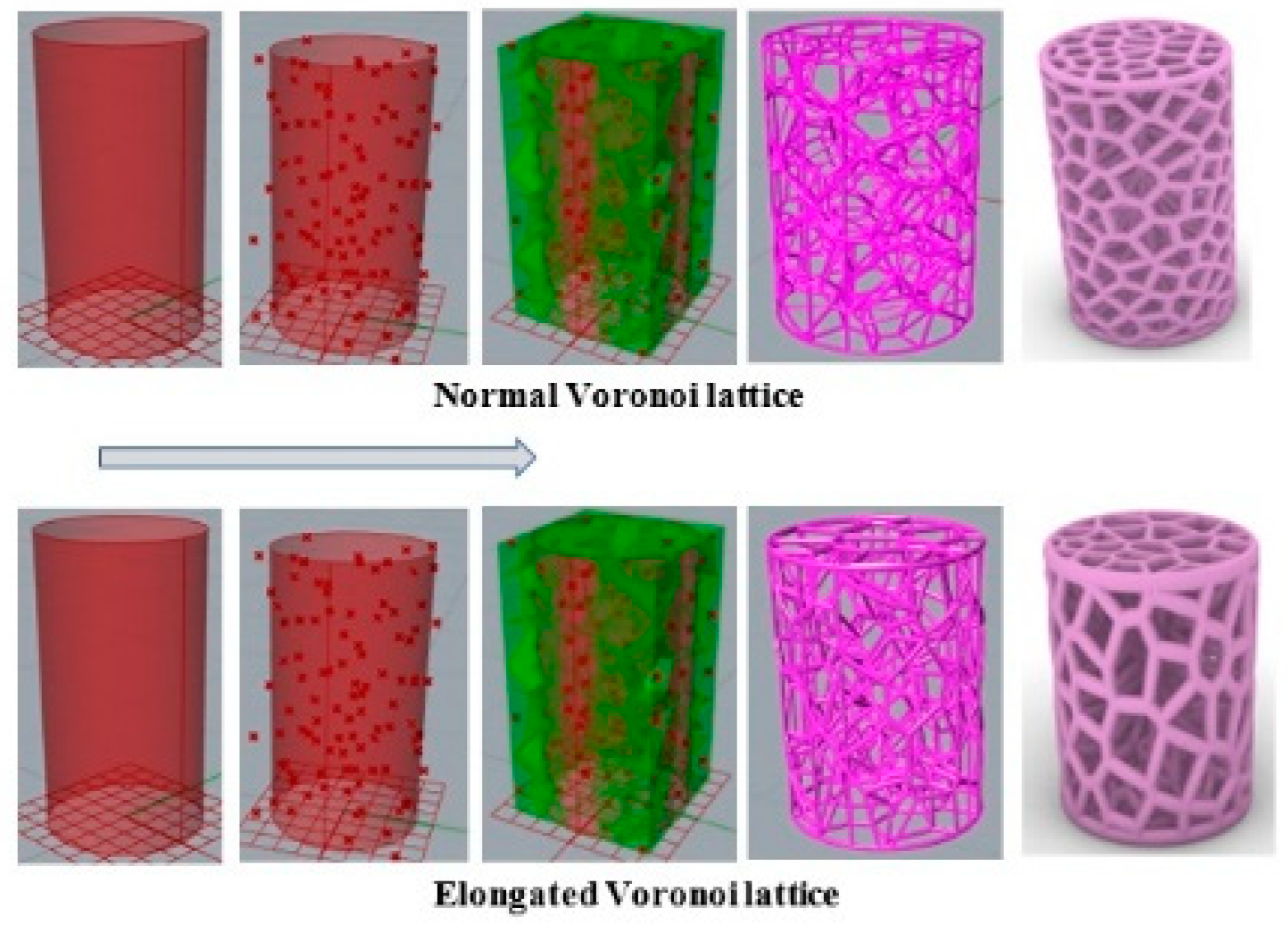
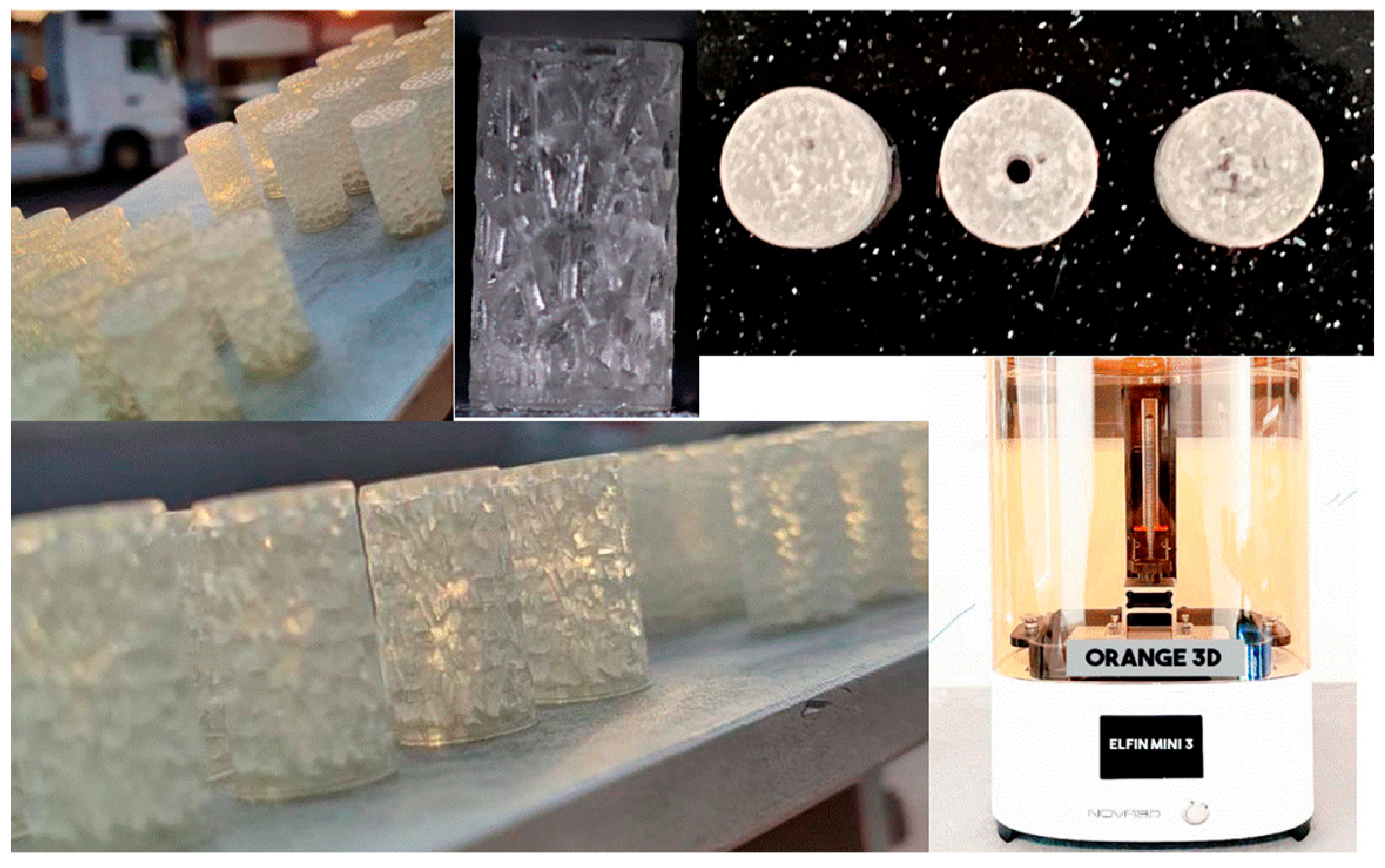


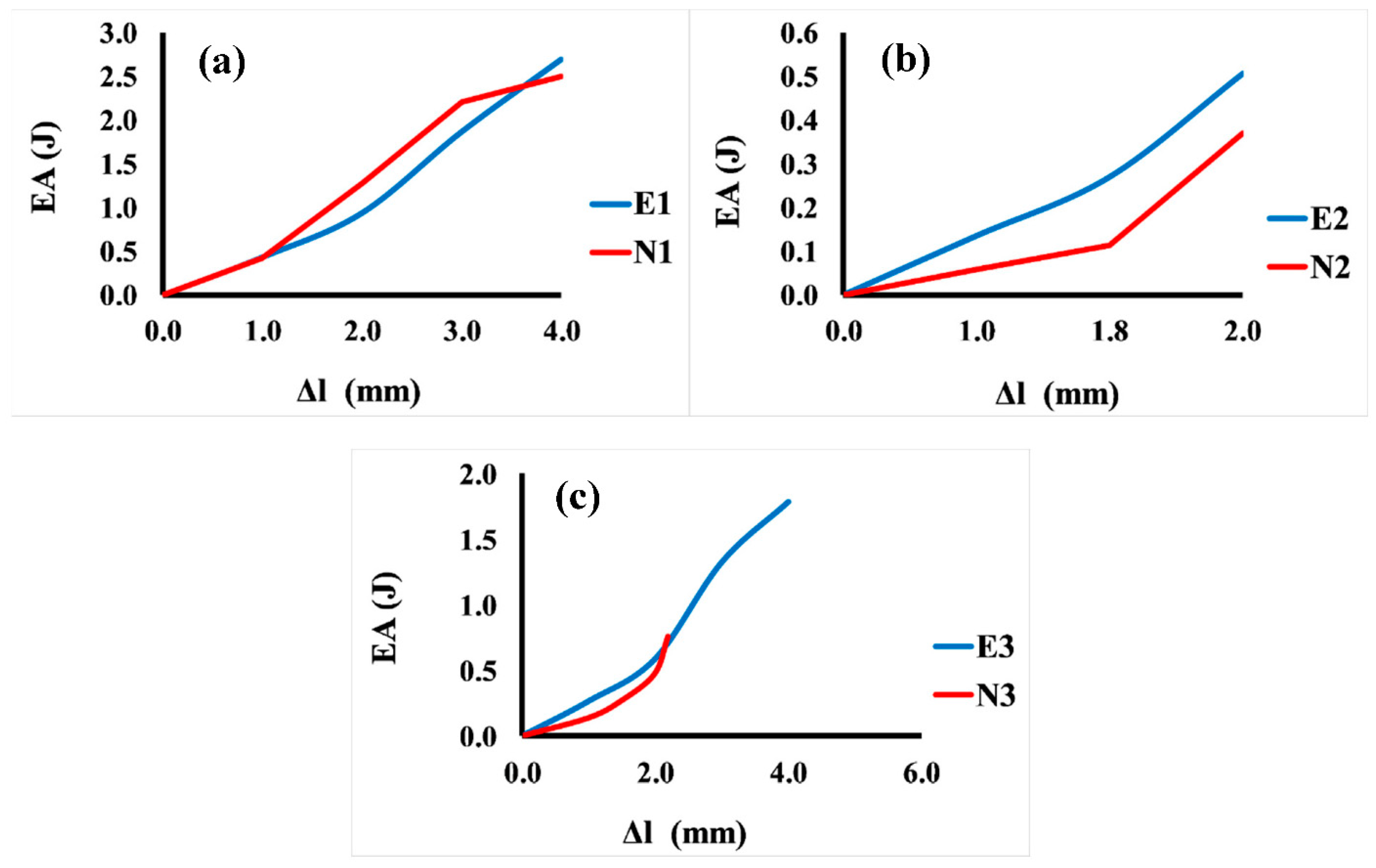

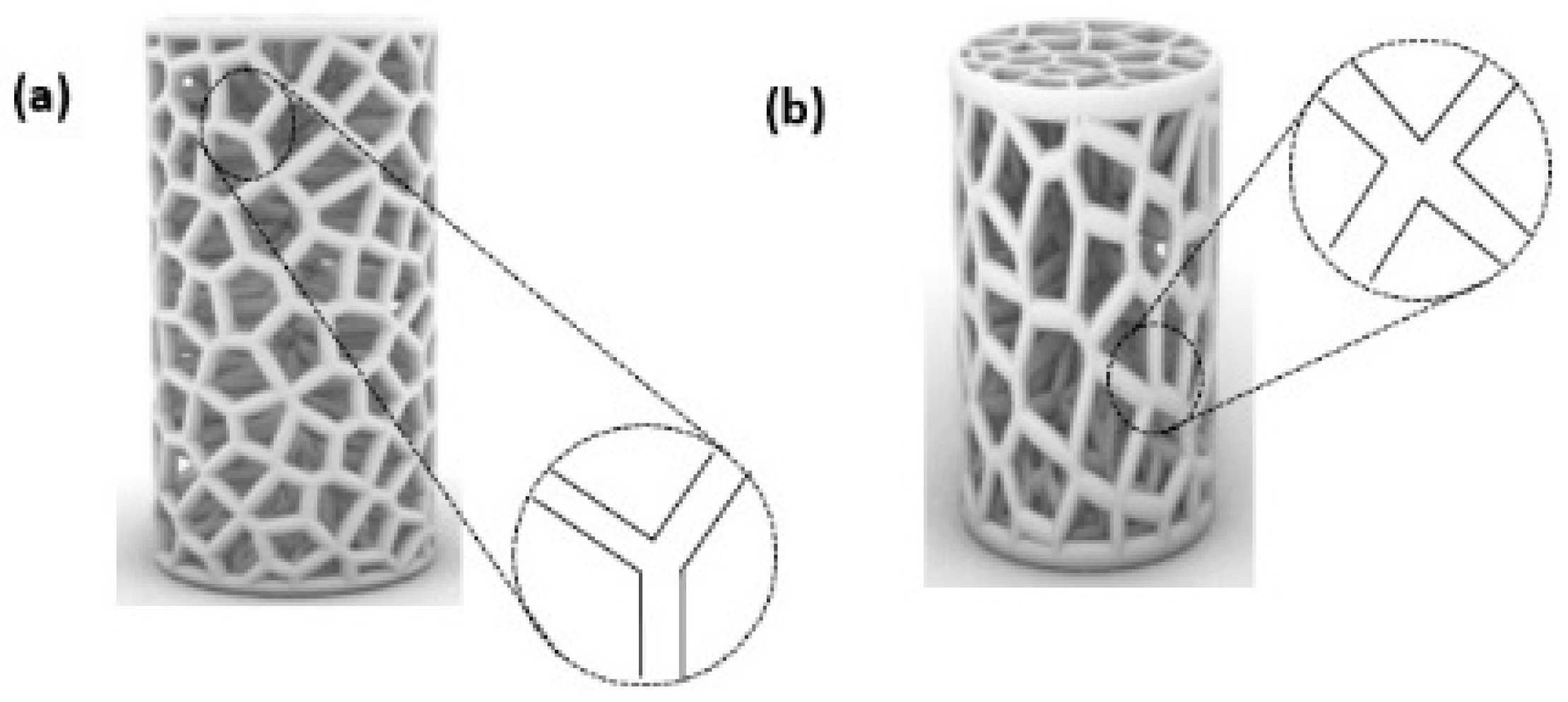

| Viscosity | Shrinkage | Vitrification Temp | Extension Strength | Bending Strength | Elongated Break |
|---|---|---|---|---|---|
| (MPa·s) (25 °C) | (%) | (°C) | (MPa) | (MPa) | (%) |
| 150–350 | 1.88–2.45 | 605 | 35–45 | 40–50 | 8–12 |
| Name of Design | Unit | E1 | E2 | E3 | N1 | N2 | N3 |
|---|---|---|---|---|---|---|---|
| Mass | g | 0.20 | 0.20 | 0.20 | 0.20 | 0.20 | 0.20 |
| Porosity | % | 64 (±1.87) | 60 (±1.23) | 64 (±0.92) | 64 (±0.84) | 60 (±1.02) | 64 (±0.78) |
| Mechanical Properties | Unit | E1 | E2 | E3 | N1 | N2 | N3 |
|---|---|---|---|---|---|---|---|
| E* | MPa | 128 (±0.64) | 142 (±0.66) | 115 (±0.59) | 120 (±0.65) | 121 (±0.62) | 112 (±0.61) |
| S* | N/mm | 352.51 (±0.98) | 286.90 (±1.06) | 302.80 (±0.95) | 380.30 (±1.02) | 272.80 (±1.04) | 336 (±0.94) |
| US | MPa | 29.00 (±0.12) | 16.30 (±0.11) | 21.39 (±0.16) | 28.22 (±0.13) | 15.80 (±0.12) | 19.18 (±0.18) |
| mm | 0.33 (±0.02) | 0.10 (±0.01) | 0.30 (±0.04) | 0.31 (±0.02) | 0.10 (±0.01) | 0.17 (±0.04) |
Publisher’s Note: MDPI stays neutral with regard to jurisdictional claims in published maps and institutional affiliations. |
© 2022 by the authors. Licensee MDPI, Basel, Switzerland. This article is an open access article distributed under the terms and conditions of the Creative Commons Attribution (CC BY) license (https://creativecommons.org/licenses/by/4.0/).
Share and Cite
Alknery, Z.; Sktani, Z.D.I.; Arab, A. Effect of Cell Geometry on the Mechanical Properties of 3D Voronoi Tessellation. J. Funct. Biomater. 2022, 13, 302. https://doi.org/10.3390/jfb13040302
Alknery Z, Sktani ZDI, Arab A. Effect of Cell Geometry on the Mechanical Properties of 3D Voronoi Tessellation. Journal of Functional Biomaterials. 2022; 13(4):302. https://doi.org/10.3390/jfb13040302
Chicago/Turabian StyleAlknery, Zainab, Zhwan Dilshad Ibrahim Sktani, and Ali Arab. 2022. "Effect of Cell Geometry on the Mechanical Properties of 3D Voronoi Tessellation" Journal of Functional Biomaterials 13, no. 4: 302. https://doi.org/10.3390/jfb13040302
APA StyleAlknery, Z., Sktani, Z. D. I., & Arab, A. (2022). Effect of Cell Geometry on the Mechanical Properties of 3D Voronoi Tessellation. Journal of Functional Biomaterials, 13(4), 302. https://doi.org/10.3390/jfb13040302







